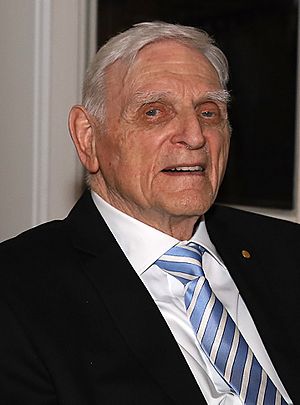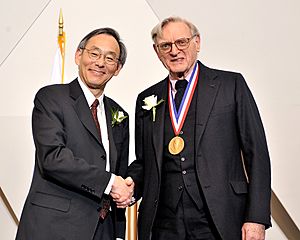John B. Goodenough facts for kids
Quick facts for kids
John B. Goodenough
|
|
|---|---|

Goodenough in December 2019
|
|
| Born |
John Bannister Goodenough
July 25, 1922 |
| Died | June 25, 2023 (aged 100) |
| Education | Yale University (BS) University of Chicago (MS, PhD) |
| Known for | Li-ion rechargeable battery Li-ion manganese oxide battery Li-ion iron phosphate battery Glass battery Goodenough–Kanamori rules Random-access memory |
| Awards | Japan Prize (2001) Enrico Fermi Award (2009) National Medal of Science (2011) IEEE Medal for Environmental and Safety Technologies (2012) Charles Stark Draper Prize (2014) Welch Award (2017) Copley Medal (2019) Nobel Prize in Chemistry (2019) |
| Scientific career | |
| Fields | Physics |
| Institutions | Massachusetts Institute of Technology University of Oxford University of Texas at Austin |
| Thesis | A theory of the deviation from close packing in hexagonal metal crystals (1952) |
| Doctoral advisor | Clarence Zener |
| Notable students | Bill David (postdoc) Arumugam Manthiram (postdoc) |
| Influences | Nevill Francis Mott John C. Slater Philip Warren Anderson Paul Hagenmuller Jay Wright Forrester |
| Influenced | Akira Yoshino C. N. R. Rao Michael M. Thackeray |
John Bannister Goodenough (born July 25, 1922 – died June 25, 2023) was an amazing American scientist. He was a physicist who studied materials. He won the Nobel Prize in Chemistry. He is famous for helping to create the lithium-ion battery. These batteries power many of our devices today. He also made important discoveries about computer memory. Goodenough was a professor at the University of Texas at Austin. He lived to be 100 years old!
Contents
Early Life and Education
John Goodenough was born in Jena, Germany, in 1922. His parents were American. His father was a professor at Yale University. John went to boarding school in Massachusetts. He studied math at Yale University and graduated in 1944.
During World War II, John served in the US Army. He worked as a meteorologist, studying weather. After the war, he went to the University of Chicago. He earned his Ph.D. in physics in 1952. While there, he met and married Irene Wiseman.
Goodenough's Scientific Career
Working at MIT Lincoln Laboratory
After his studies, Goodenough became a research scientist. He worked at MIT's Lincoln Laboratory for 24 years. There, he helped develop random access magnetic memory. This type of memory is used in computers. His work also led to rules for how magnetism works in materials. These are called the Goodenough–Kanamori rules.
Developing Batteries at Oxford
In the late 1970s, Goodenough moved to the University of Oxford in England. He led the Inorganic Chemistry Laboratory. At Oxford, he did very important research on lithium-ion rechargeable batteries. He built on earlier work by M. Stanley Whittingham.
In 1980, Goodenough found a way to make lithium-ion batteries much better. He discovered that using a material called LixCoO2 as a cathode could double the battery's power. This material was light and held a lot of energy. His discovery was later used by Sony to create the first commercial lithium-ion batteries. Akira Yoshino helped improve the battery design for Sony.
Goodenough received the Japan Prize in 2001 for his battery discoveries. In 2019, he, Whittingham, and Yoshino shared the Nobel Prize in Chemistry. Goodenough was 97 years old, making him the oldest person to win a Nobel Prize!
Research at the University of Texas
Since 1986, Goodenough was a professor at The University of Texas at Austin. He continued his research on materials for batteries. He wanted to find better materials to help develop electric vehicles. This would help reduce our use of fossil fuels.
He and his team discovered a new type of battery material called polyanions. These materials help batteries produce higher voltages. They are used in smaller devices like power tools. Goodenough kept working at the university even when he was 98 years old. He hoped to find another big breakthrough in battery technology.
In 2017, Goodenough and his team published a paper about a new type of battery. It was called a glass battery. This battery was supposed to be low-cost and safe. It would not catch fire and could last a long time. However, some scientists had questions about this new battery.
Awards and Recognition

Professor Goodenough was recognized for his work many times. He became a member of the National Academy of Engineering in 1976. This was for his work on materials for electronics. He was also a member of other important science academies around the world.
He wrote over 550 articles and several books. In 2009, he received the Enrico Fermi Award for his work on lithium-ion batteries. In 2013, President Barack Obama gave him the National Medal of Science. He also won the Draper Prize in engineering.
In 2019, he received the Copley Medal from the Royal Society. The Royal Society of Chemistry even created an award named after him: the John B Goodenough Award.
His greatest honor was the Nobel Prize in Chemistry in 2019. He shared it with M. Stanley Whittingham and Akira Yoshino. This award celebrated their work on lithium-ion batteries.
Personal Life
John Goodenough turned 100 years old on July 25, 2022. He passed away on June 25, 2023.
See also
 In Spanish: John B. Goodenough para niños
In Spanish: John B. Goodenough para niños
- Koichi Mizushima (scientist)
- Rachid Yazami


